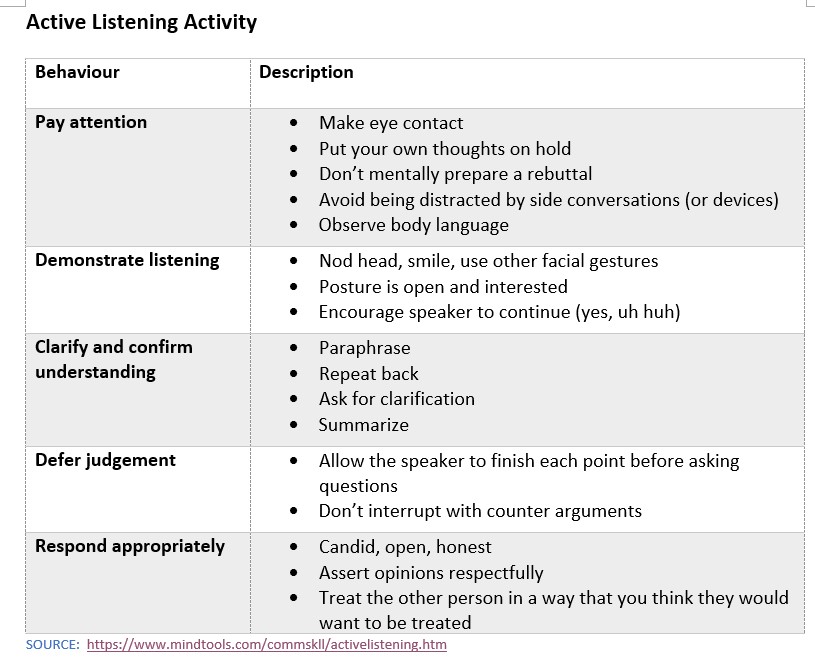In a recent team building session with a staff team, I spontaneously facilitated an Active Listening technique as a group activity to help the participants enhance their communication skills. I usually use Active Listening with individuals talking in pairs. In this session, I took another step and used it in a group with the entire 8-member team; something I have not done before. It worked great!
Active listening is a communication skill that involves paying full attention to what someone is saying and responding in a way that shows understanding and empathy. It helps build stronger relationships, reduces misunderstandings, and fosters mutual respect and trust.
To facilitate Active Listening in pairs, I and other facilitators I have observed will:
- Explain the purpose of Active Listening and how to conduct it.
- Invite participants to work in pairs.
- One person talks about a topic for two minutes.
- The second person listens without talking, demonstrates interest and attention, and does not prepare their response.
- The individuals then switch roles.
- We debrief the experience.

Does the activity work with a group? Yes!
During the session, I facilitated the pair activity with the eight team members working in pairs and going through two rounds of Active Listening with different partners. While we were preparing for the session, this team stated that they needed to improve their communication as a group. Because of this, I realized that they could practice Active Listening as a group, an approach I had not previously used.
The Group Activity
- After the team members had experienced Active Listening with several partners, I invited the group to select a topic that they were currently working on.
- Then, I invited them to discuss the topic as a large group and practice Active Listening skills.
- The group talked for about ten minutes. The discussion flowed naturally with one person talking at a time. We did not give a time requirement.
- When one speaker finished, any of the others could ask clarifying questions, paraphrase, and then respond with their opinion or a new idea.
- Individuals spoke as often as they wanted, yet only one at a time.
- They then chose a second topic and conducted a second discussion.
In the debrief on the group Active Listening activity, the team members said:
- They felt tranquil and calm.
- They could hear what each person said.
- Each person talked without interruptions.
- They felt that others were listening.
- Some said they struggled with paying attention rather than formulating a response and were afraid they would forget what they wanted to talk about. Their colleagues encouraged them to write notes about the points they wanted to discuss.
I am curious to know how other facilitators have used Active Listening with a group rather than in pairs. Please comment or contact me.
RESOURCES TO CHECK OUT
The HEAR strategy
https://www.edutopia.org/blog/training-the-brain-to-listen-donna-wilson
Donna Wilson, PhD, educational and school psychologist
Halt: Stop whatever else you are doing, end your internal dialogue on other thoughts, and free your mind to pay attention to the person speaking.
Engage: Focus on the speaker. We suggest a physical component, such as turning your head slightly so that your right ear is toward the speaker as a reminder to be engaged solely in listening.
Anticipate: By looking forward to what the speaker has to say, you are acknowledging that you will likely learn something new and interesting, which will enhance your attention.
Replay: Think about what the speaker is saying. Analyze and paraphrase it in your mind or in discussion with the speaker and other classmates. Replaying the information will aid in understanding and remembering what you have learned.
The BUILD strategy (with my comments)
Jacob Morgan, author, speaker and futurist
https://jacobm.medium.com/5-ways-to-practice-active-listening-924b58746494
Body language – give positive messages through an open stance and good posture
Understanding – listen to understand what is being said
Interrupting – don’t do it.
Look them in the eye – when culturally appropriate
Don’t judge – practice empathy and put yourself in the other person’s shoes

